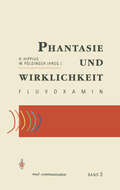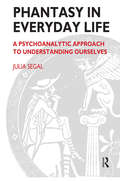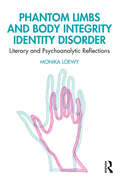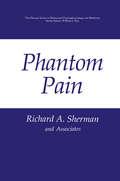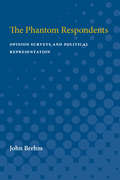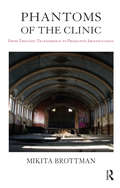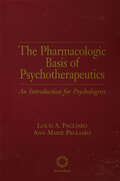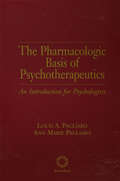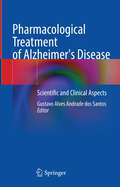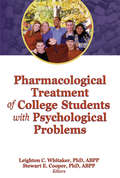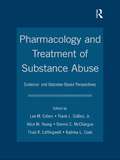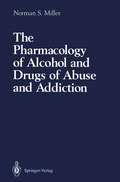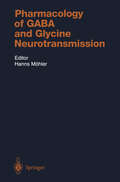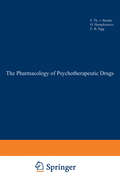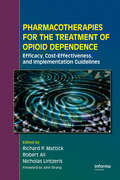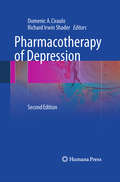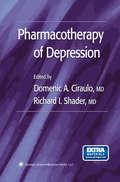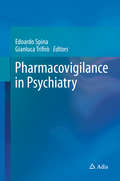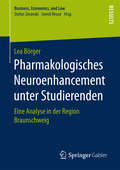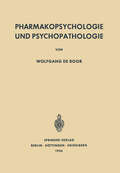- Table View
- List View
Phantasie und Wirklichkeit — Fluvoxamin (duphar med communication)
Das letzte wissenschaftliche Symposium in einer Dreierreihe zum Serotoninsystem handelte tiber Fluvoxamin. Fluvoxamin ist das erste Arzneimittel, das sich als Vertreter eines neuen Therapieprinzips, dem der Serotonin-Wiederaufnahmehemmung, bei der Behandlung von Depressionen bewahrt hat. Weil Fluvoxamin eine hohe Selektivitat gegentiber Serotonin Rezeptoren besitzt, ist dieses neue Antidepressivum auch zu einer wichtigen "Modellsubstanz" geworden, die es erlaubt, Zusammen hange und Wechselbeziehungen zwischen den serotonergen, adrener gen und dopaminergen Neurotransmitterveranderungen im Zentral nervensystem sowohl im Tierversuch als auch bei der klinischen Anwendung zu untersuchen. Da das Serotonin system verschiedene "Verhaltens-Elemente" beeinfluBt, werden mit Untersuchungen die ses Neurotransmittersystems auch Moglichkeiten aufgezeigt, andere psychische Storungen (z. B. Angst, Aggression, Zwang, EBstorungen) neurobiologisch zu erforschen. Mit den Serotonin-Wiederaufnahme hemmern eroffnen sich in der Zukunft womoglich auch neue Perspek tiven, die Beziehungen zwischen biologischen Dysfunktionen und psychischen StOrungen gezieJt zu untersuchen. Ansatze dieser weiter ftihrenden Grundlagenforschung haben das Ziel, neue Therapie Ansatze zu erforschen. Am Beispiel der Geschichte der Entwicklung und klinischen Erfor schung aller Psychopharmaka lassen sich wechselseitige Verflechtun gen und Abhangigkeiten in Forschungsprogrammen skizzieren: Von der Phantasie, der Idee der Forscher im Labor, gelangt man tiber neue Erkenntnisse in der neurobiologischen Forschung zu Ergebnissen und Befunden in der Klinik. Diese konnen dann als Elemente der klini schen Wirklichkeit wieder die Grundlagenforschung befruchten.
Phantasy in Everyday Life: A Psychoanalytic Approach to Understanding Ourselves (Pelican Ser.)
by Julia SegalOver the past fifty years dramatic ideas and discoveries have arisen out of the work of analysts. In Phantasy in Everyday Life the author is mainly concerned with Melanie Klein's contribution to the field and with everyday application of her theories. Central to the author's theme is Melanie Klein's concept of phantasy - the unconscious fantasies which control our assumptions, our thoughts, our emotions and our behavior. The first half of the book is concerned with daily life; the second more with theoretical issues. Written from her direct experience,the author's work will prove invaluable both to professionals and to the wider general public.
Phantasy in Everyday Life: A Psychoanalytic Approach to Understanding Ourselves
by Julia SegalOver the past fifty years dramatic ideas and discoveries have arisen out of the work of analysts. In Phantasy in Everyday Life the author is mainly concerned with Melanie Klein's contribution to the field and with everyday application of her theories. Central to the author's theme is Melanie Klein's concept of phantasy - the unconscious fantasies which control our assumptions, our thoughts, our emotions and our behavior. The first half of the book is concerned with daily life; the second more with theoretical issues. Written from her direct experience,the author's work will prove invaluable both to professionals and to the wider general public.
Phantom Limbs and Body Integrity Identity Disorder: Literary and Psychoanalytic Reflections
by Monika LoewyPhantom Limbs and Body Integrity Identity Disorder discusses the conditions of Phantom Limb Syndrome and Body Integrity Identity Disorder together for the first time, exploring examples from literature, film, and psychoanalysis to re-ground theories of the body in material experience. The book outlines the ways in which PLS and BIID involve a feeling of rupture underlined by a desire for wholeness, using the metaphor of the mirror-box (a therapeutic device that alleviates phantom limb pain) to examine how fiction is fundamentally linked to our physical and psychical realities. Using diverse examples from theoretical and fictional works, including thinkers such as Sigmund Freud, Jacques Lacan, Maurice Blanchot, D.W. Winnicott, and Georges Perec, and films by Powell and Pressburger and Quentin Tarantino, each chapter offers a detailed exploration of the mind/body relationship and experiences of fragmentation, bodily ownership, and symbolic reconstitution. By tracing these concepts, the monograph demonstrates ways in which fiction can enable us to understand the psychosomatic conditions of PLS and BIID more thoroughly, while providing new ways of reading psychoanalysis, literary theory, and fictional works. The first book to analyse BIID in relation to PLS, Phantom Limbs and Body Integrity Identity Disorder will be essential reading for academics and literary readers interested in the body, psychoanalysis, English literature, literary theory, film, and disability.
Phantom Limbs and Body Integrity Identity Disorder: Literary and Psychoanalytic Reflections
by Monika LoewyPhantom Limbs and Body Integrity Identity Disorder discusses the conditions of Phantom Limb Syndrome and Body Integrity Identity Disorder together for the first time, exploring examples from literature, film, and psychoanalysis to re-ground theories of the body in material experience. The book outlines the ways in which PLS and BIID involve a feeling of rupture underlined by a desire for wholeness, using the metaphor of the mirror-box (a therapeutic device that alleviates phantom limb pain) to examine how fiction is fundamentally linked to our physical and psychical realities. Using diverse examples from theoretical and fictional works, including thinkers such as Sigmund Freud, Jacques Lacan, Maurice Blanchot, D.W. Winnicott, and Georges Perec, and films by Powell and Pressburger and Quentin Tarantino, each chapter offers a detailed exploration of the mind/body relationship and experiences of fragmentation, bodily ownership, and symbolic reconstitution. By tracing these concepts, the monograph demonstrates ways in which fiction can enable us to understand the psychosomatic conditions of PLS and BIID more thoroughly, while providing new ways of reading psychoanalysis, literary theory, and fictional works. The first book to analyse BIID in relation to PLS, Phantom Limbs and Body Integrity Identity Disorder will be essential reading for academics and literary readers interested in the body, psychoanalysis, English literature, literary theory, film, and disability.
Phantom Pain (The Springer Series in Behavioral Psychophysiology and Medicine)
by Richard A. ShermanPhantom pain is an intriguing mystery that has captured the imagination of health care providers and the public alike. How is it possible to feel pain in a limb or some other body part that has been surgically removed? Phantom pain develops among people who have lost a limb or a breast or have had internal organs removed. It also occurs in people with totally transected spinal cords. Unfortunately, phantom pain is a medical night mare. Many of the people reporting phantom pain make dispropor tionately heavy use of the medical system because their severe pains are usually not treated successfully. The effect on quality of life can be devas tating. Phantom pain has been reported at least since 1545 (Weir Mitchell as related by Nathanson, 1988) and/ or experienced by such diverse people as Admiral Lord Nelson and Ambroise Pare (Melzack & Wall, 1982; Davis, 1993). The folklore surrounding phantom pain is fascinating and mirrors the concepts about how our bodies work that are in vogue at any particu lar time. Most of the stories relate to phantom limbs and date from the mid-1800s. The typical story goes like this: A man who had his leg ampu tated complained about terrible crawling, twitching feelings in his leg. His friends found out where the leg was buried, dug it up, and found maggots eating it. They burned it, and the pain stopped. Another man complained of a swollen feeling with frequent stinging or biting pains.
The Phantom Respondents: Opinion Surveys and Political Representation (Michigan Studies In Political Analysis)
by John O. BrehmExamines a fundamental problem for opinion polls and those who use them.
Phantoms of the Clinic: From Thought-Transference to Projective Identification
by Mikita BrottmanAs Freud predicted, there has always been great anxiety about the place of psychoanalysis in contemporary life, particularly in relation to its ambiguous and complicated relationship to the realm of science. There is also a long history of widespread resistance, in both academia and medicine, to anything associated with the world of the supernatural; very few people, in their professional lives, at least, are willing to admit a serious interest in occult phenomena. As a result, paranormal traces have all but vanished from the psychoanalytic process - though not without leaving a residue. This residue remains, the author argues, in the acceptably "clinical" guise of projective identification, a concept first formulated by Melanie Klein, and widely used in contemporary psychoanalysis to suggest a different variety of transference and transference-like phenomena between patient and analyst that seem to occur outside the normal range of the sensory process.
Phantoms of the Clinic: From Thought-Transference to Projective Identification
by Mikita BrottmanAs Freud predicted, there has always been great anxiety about the place of psychoanalysis in contemporary life, particularly in relation to its ambiguous and complicated relationship to the realm of science. There is also a long history of widespread resistance, in both academia and medicine, to anything associated with the world of the supernatural; very few people, in their professional lives, at least, are willing to admit a serious interest in occult phenomena. As a result, paranormal traces have all but vanished from the psychoanalytic process - though not without leaving a residue. This residue remains, the author argues, in the acceptably "clinical" guise of projective identification, a concept first formulated by Melanie Klein, and widely used in contemporary psychoanalysis to suggest a different variety of transference and transference-like phenomena between patient and analyst that seem to occur outside the normal range of the sensory process.
The Pharmacologic Basis of Psychotherapeutics: An Introduction For Psychologists
by Louis A. Pagliaro Ann M. PagliaroFirst published in 1998. Routledge is an imprint of Taylor & Francis, an informa company.
The Pharmacologic Basis of Psychotherapeutics
by Louis A. Pagliaro Ann M. PagliaroFirst published in 1998. Routledge is an imprint of Taylor & Francis, an informa company.
Pharmacological Treatment of Alzheimer's Disease: Scientific and Clinical Aspects
by Gustavo Alves Andrade dos SantosAlzheimer’s disease is the most prevalent form of dementia. Although it was discovered about a century ago, the first drugs applied in treatment were only introduced in therapy in the last 30 years.This book focuses on the clinical pharmacology of drugs that aim to delay the progression of Alzheimer’s disease, such as anticholinesterases and glutamate receptor antagonists, as well as treatment for the behavioral changes caused by the progression of the disease: antidepressants, antipsychotics, anxiolytics, and mood stabilizers.In addition, it describes important information about the pathophysiology and diagnostic methods of Alzheimer’s disease, emergency situations conditioned by the dementia process, and presents new perspectives for the treatment of Alzheimer’s disease. The ten chapters cover topics such as mechanism of action, dosage regimen, adverse reactions, drug interactions, toxicity profiles, among other information of clinical relevance. The work comprises evidence-based studies, providing a valuable resource for analyzing, prescribing and monitoring patients being treated for Alzheimer’s disease.Written by experts with solid professional experience, this book will appeal to pharmacologists, geriatricians, neurologists, psychiatrists, biomedical clinicians, and other healthcare professionals.
Pharmacological Treatment of College Students with Psychological Problems
by Leighton C. Whitaker Stewart E. CooperGet valuable insights into best practices and procedures for treatment Mental health practitioners across the country are increasingly treating students by combining the use of psychotropic medication with psychotherapy. Pharmacological Treatment of College Students with Psychological Problems explores in detail this uncritically accepted exponential expansion of the practice. Leading psychiatrists, psychologists, and social workers discuss the crucial questions and problems encountered in this widespread practice, and also present specific and differing models of combined therapy. This book critically examines several of the key issues, practices, and competing perspectives. Professionals working in college mental health are provided with valuable insights into best practices and procedures in split and integrated treatment. Various clinicians beyond the psychiatric field are prescribing psychotropic medications with increasing frequency. Pharmacological Treatment of College Students with Psychological Problems presents a wide range of viewpoints on this issue, offering evidence, arguments, and recommendations to clearly illustrate the need for increased attention to the use of psychotropic medications and show how psychotherapy may be safer and more beneficial. Chapters include discussions on withdrawing from medication successfully, long term perturbation effects, and differing models of combined therapy in practice. This resource is comprehensively referenced. Topics in Pharmacological Treatment of College Students with Psychological Problems include: identification of the key issues and practices of combining psychotropic medication with counseling in treatment elements of two separate university counseling centers and how they provide combined treatment emerging research on perturbation effects of use of psychotropic medications best practices in the combined treatment in college settings key unresolved questions that need further research bringing a more sophisticated level in the practice of combined treatment with college students Pharmacological Treatment of College Students with Psychological Problems is a valuable resource for all professionals from seasoned professionals to beginning practicum students.
Pharmacological Treatment of College Students with Psychological Problems
by Leighton Whitaker Stewart CooperGet valuable insights into best practices and procedures for treatment Mental health practitioners across the country are increasingly treating students by combining the use of psychotropic medication with psychotherapy. Pharmacological Treatment of College Students with Psychological Problems explores in detail this uncritically accepted exponential expansion of the practice. Leading psychiatrists, psychologists, and social workers discuss the crucial questions and problems encountered in this widespread practice, and also present specific and differing models of combined therapy. This book critically examines several of the key issues, practices, and competing perspectives. Professionals working in college mental health are provided with valuable insights into best practices and procedures in split and integrated treatment. Various clinicians beyond the psychiatric field are prescribing psychotropic medications with increasing frequency. Pharmacological Treatment of College Students with Psychological Problems presents a wide range of viewpoints on this issue, offering evidence, arguments, and recommendations to clearly illustrate the need for increased attention to the use of psychotropic medications and show how psychotherapy may be safer and more beneficial. Chapters include discussions on withdrawing from medication successfully, long term perturbation effects, and differing models of combined therapy in practice. This resource is comprehensively referenced. Topics in Pharmacological Treatment of College Students with Psychological Problems include: identification of the key issues and practices of combining psychotropic medication with counseling in treatment elements of two separate university counseling centers and how they provide combined treatment emerging research on perturbation effects of use of psychotropic medications best practices in the combined treatment in college settings key unresolved questions that need further research bringing a more sophisticated level in the practice of combined treatment with college students Pharmacological Treatment of College Students with Psychological Problems is a valuable resource for all professionals from seasoned professionals to beginning practicum students.
Pharmacology and Treatment of Substance Abuse: Evidence and Outcome Based Perspectives (Counseling and Psychotherapy)
by Lee M. Cohen Frank L. Collins Jr. Alice M. Young Dennis E. McChargue Thad R. Leffingwell Katrina L. CookGiven the prevalence of substance abuse in general clinical populations, it is important for healthcare providers to have knowledge and skill in the treatment of these problems. Evidence-Based Practice (EBP) involves the integration of the best evidence with clinical expertise and patient values. This text is designed as a bridge for practitioners that will provide up-to-date evidence reviews as well as information on how to best keep up with emerging trends in the field. The editors have gathered expert authors to provide a much needed summary of the current status of the evidence based practice for both the assessment and treatment of specific substance use disorders.
Pharmacology and Treatment of Substance Abuse: Evidence and Outcome Based Perspectives (Counseling and Psychotherapy)
by Lee M. Cohen Alice Young Dennis E. McChargue Thad R. Leffingwell Katrina L. Cook Frank L. Collins Jr.Given the prevalence of substance abuse in general clinical populations, it is important for healthcare providers to have knowledge and skill in the treatment of these problems. Evidence-Based Practice (EBP) involves the integration of the best evidence with clinical expertise and patient values. This text is designed as a bridge for practitioners that will provide up-to-date evidence reviews as well as information on how to best keep up with emerging trends in the field. The editors have gathered expert authors to provide a much needed summary of the current status of the evidence based practice for both the assessment and treatment of specific substance use disorders.
The Pharmacology of Alcohol and Drugs of Abuse and Addiction
by Norman S. MillerThis volume is intended for clinicians, researchers, residents, and students. The range is wide and the depth considerable for all the topics covered in the treatment of this timely and relevant subject. This book may serve equally well as a general introduction and a scholarly reference. Ultimately, it is designed to serve those patients suffering from abuse of and addiction to drugs and alcohol. The content and organization of the book flow from general concepts of abuse and addiction to specific details of the pharmacology of alcohol and drugs. Special chapters on topics not found in most other books, such as pharmacology of drug-drug interactions, abstinence, and prevention, are included. This book is written especially for the clinician interested in the pharma cology of alcohol and drugs of abuse and addiction. The pharmacology is integrated into a conceptual approach to diagnosis and treatment of alcohol and drug abuse and addiction. The form and style are didactic, critical as well as straightforward in presentation. Literature references from recent clinical research and basic research provide the foundation for the chapters throughout the book. Be cause the book is written by a clinician-researcher, the information is readily adaptable to clinical problems and research ideas. I would like to express my deep appreciation to Susan Newsom and Darlene Tucci for their invaluable technical assistance. Norman S. Miller vii Contents Preface ....................................................... vii CHAPTER 1 Introduction to the Pharmacological Effects of Alcohol and Drugs and Addiction on the Brain and Behavior .... . . . . . . . . . . . . . . . . . .. . . 1 . . . . . .
Pharmacology of GABA and Glycine Neurotransmission (Handbook of Experimental Pharmacology #150)
by Hanns MöhlerHighlighting the current developments and future directions in GABA and glycine research, this volume covers the major inhibitory neurotransmitters from the molecular mechanisms of signal transduction to their role in health and disease. It is of topical importance because these neurotransmitters are essential for brain function and therapy of diseases such as anxiety disorders, insomnias, epilepsy, depression, spasticity, and memory deficits. Distinguished scientists at the forefront of research contributed reviews on the role of these transmitters in governing neuronal networks, their signalling pathways, their receptors, the pharmacology of GABA A- and GABA B- and GABA C-receptors as well as of GABA- and glycine-transporters, and their role in disease. The volume serves as reference for pharmacologists/toxicologists, neuroscientists, neurologists and psychiatrists.
The Pharmacology of Psychotherapeutic Drugs (Heidelberg Science Library)
by Franz T.v. Brücke Oleh Hornykiewicz Ernest B. SiggPharmacotherapies for the Treatment of Opioid Dependence: Efficacy, Cost-Effectiveness and Implementation Guidelines
by Richard P. Mattick Robert Ali Nicholas LintzerisThe most comprehensive text of its kind, this book addresses both the management of opioid withdrawal and opioid maintenance therapy, and combines up-to-date reviews of the scientific literature with evidence-based clinical guidelines for all of the relevant pharmacotherapies. A unique work, Pharmacotherapies for the Treatment of Opioid Dependence
Pharmacotherapy of Depression
by Domenic A. A. Ciraulo and Richard Irwin Irwin ShaderComprehensive and state of the art, the second edition of Pharmacotherapy of Depression offers major revisions of every chapter and the addition of new chapters by expert contributors. The first chapter reviews the neurobiology of depression, which lays the groundwork for understanding the mechanisms of action of antidepressants. In the next chapter, a review of the general principles guiding the diagnosis and medication treatment of unipolar depression is provided. The clinical pharmacology of antidepressants is reviewed in some detail, supplemented by tables that provide information on dosing, indications, and metabolism. Augmentation strategies are reviewed, including the use of non-traditional agents. The chapters that follow next address the use of antidepressants in special populations, such as the elderly and depressed individuals with psychosis, bipolar disorder, substance abuse, and post traumatic stress disorder. The complex issues involving the diagnosis and treatment of depression during pregnancy is thoroughly reviewed in Chapter 8 and provides a synthesis of the scientific literature in the area, one that is noted for contradictory and controversial findings, as well as guidelines for prescribing. The next chapter then provides an overview of the treatment of depression in the pediatric population, highlighting clinical concerns such as suicide risk. The book concludes with two chapters at the interface of medicine and psychiatry in the treatment of mood disorders: managing depression in primary care settings and depression associated with medical illnesses. The outstanding clinician-scientists who have contributed to this volume are all leaders in their fields and represent a broad spectrum of renowned institutions. A timely contribution to the literature, The Pharmacotherapy of Depression, Second Edition, offers busy clinicians from many disciplines a strong scientific foundation that seamlessly transitions into practical recommendations for clinical practice. The result is another gold-standard guide to the safe and effective use of the latest antidepressant medications.
Pharmacotherapy of Depression: Application For The Outpatient Practitioner
by Richard I. Shader Domenic A. CirauloFor many years, we have taught clinical psychopharmacology to residents in psychiatry, neurology, and medicine, as well as to medical students, nurses, psychologists, counselors, and social workers. We have also maintained active clinical practices and research programs. It is our hope that these experiences have produced a book that will serve as a resource in antidepressant therapy for clinicians from many different disciplines. The purpose of Pharmacotherapy of Depression is to provide a compreh- sive overview of antidepressant therapy for clinicians. The contents have evolved from our years of seminars, lectures, and case discussions with our trainees and from our continuing medical education programs. We have tried to provide sufficient depth in reviews of the research literature to support clinical rec- mendations without burdening the reader with information that has little r- evance to the clinical use of antidepressants. We are indebted to the outstanding clinician scientists who have contributed to this volume and to our students who have guided us in its development. We hope that the reader will find that the final product represents a solid foundation for clinicians who are, or will be, prescribing antidepressants. It comes very close to replicating the formal didactics that our trainees experience. Although in practice we supplement this with intensive supervision of patient management, we hope that Pharmacotherapy of Depression will stand alone as a guide to the use of medications for the treatment of depressive illness.
Pharmacovigilance in Psychiatry
by Edoardo Spina Gianluca TrifiròThe first authoritative textbook specifically addressing issues of the field, this book delivers a focused discussion on several themes in psychiatry while providing a sound background on pharmacovigilance. Internationally-recognised researchers, clinicians and pharmacovigilance experts contributed to this textbook, giving it the benefit of different perspectives and years of experience. Pharmacovigilance in psychiatry provides a thorough introduction to this field but goes on to explore advanced themes such as methodologies and resources used for pharmacovigilance in psychiatry, challenges as well as most recent developments to this field, making it suitable for under-graduates, graduate and post-doctoral students and persons working pharmacovigilance who seek to broaden their knowledge on this subject.
Pharmakologisches Neuroenhancement unter Studierenden: Eine Analyse in der Region Braunschweig (Business, Economics, and Law)
by Lea BörgerLea Börger geht der Frage nach, wie verbreitet pharmakologische Neuroenhancements unter Studierenden sind und welchen Einfluss sie haben. Die Autorin führt eine Online-Befragung von 1.737 Studierenden der drei Hochschulen in der Region Braunschweig durch. Ein eigens konstruierter Fragebogen ermittelt die Verwendung von verschreibungspflichtigen Medikamenten, illegalen Drogen und freiverkäuflichen Präparaten, aufgeschlüsselt nach den Motiven kognitiver Leistungssteigerung und Stimmungsverbesserung bzw. Abbau von Angst und Nervosität. Es zeigt sich, dass die Prävalenzen gering sind, jedoch gegenüber anderen Untersuchungen an deutschen Universitäten erhöht sind. Daher sollten Trends beobachtet werden.
